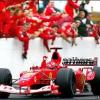I'm also very concerned about F1's handling of track safety, but I'm interested in solutions that work and not the over-simplified solutions offered by the Villeneuves of this world. I think there are circumstances in which there's nothing wrong with sending a marshal onto the track to do a specific job, e.g. picking up debris, under a local yellow. So I wouldn't support a blanket ban on the practice, but I think the post chief and the race director have to have various options at their disposal depending on the type of on-track intervention that is required, to make sure their people are protected, that cars on track are required by enforceable and enforced regulations to respond appropriately to incidents as directed by the flaggies and by race control, and to design these systems intelligently so that we're neither over-reacting by slowing the cars down on parts of the track where it isn't necessary to slow them, nor under-reacting by letting them come barelling through past the incident at high speed with just a half a second lift.
Where marshals don't need prolonged access to the racing line I would argue that local slow zones are, as a response, both more proportionate than a safety car and, crucially, safer than a safety car. The trouble with safety cars is they slow the cars both too much and too little: too little to be sure to provide a decent, safe working environment for marshals, and too much to allow the cars to run behind the safety car without having to resort to desperate weaving and erratic acceleration and braking and general fiddling with settings in order to ameliorate the inherent problems of overheating and loss of brake and tyre temps.
Local slow zones would allow race control to set a specific speed limit between any two marshals' posts, covering both the approach to the scene of the incident and the scene itself, thereby ensuring that cars will pass the incident much more slowly than they would under SC deltas, but because they would still be allowed to go at full racing speed for the rest of the lap, there would be no significant loss of temperature problem. That's a win-win for the marshals, medics, drivers and anybody else who may be present on the track. The only trouble with it is it's much fairer, in sporting terms, than a safety car in that it minimises the impact on the race, which will never do in the current climate of gimmickry and artificially bunching the field and trying to provoke accidents with standing restarts, etc. But it works in WEC, and with the advanced track status dash warning lights, information and timing loop delta systems that F1 already has, it could work even better in F1, because F1 would have the ability to manage the slowing down zones on the approach to the slow zones more tightly than the ACO currently can.
The other good thing about slow zones is that even if the situation is such that the field does need to be bunched up to give marshals prolonged access to the track including the racing line, there's nothing stopping race control from imposing a slow zone at the incident scene as well to ensure drivers go extra-slowly past the incident even before they catch the SC queue.
If we're going to have cars being removed during racing it's now clear that we need a better solution than exclusive reliance on either local yellows, or the massive over-reaction of a full-course caution for a localised issue that doesn't even require access to the track. Local slow zones are better for the racing and they're safer than using the SC all the time.
Edited by redreni, 07 October 2014 - 20:07.





























